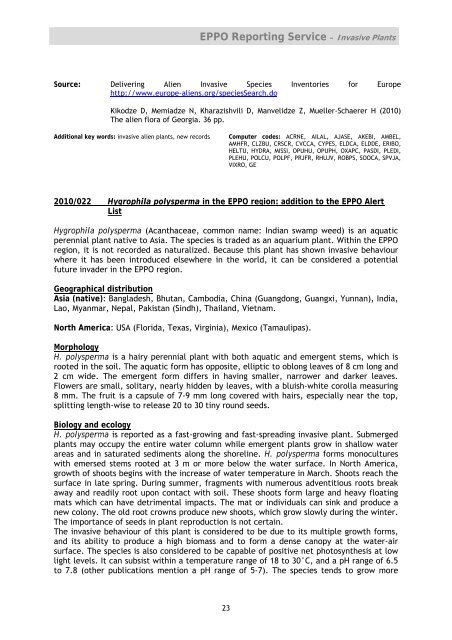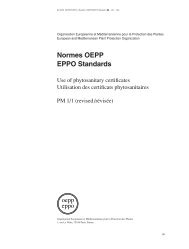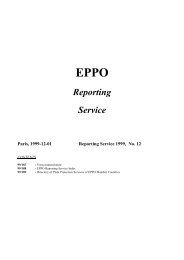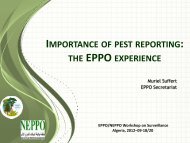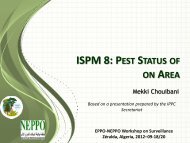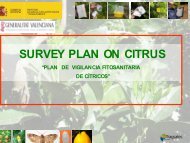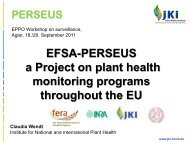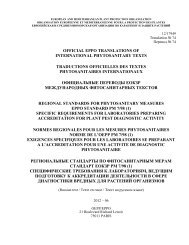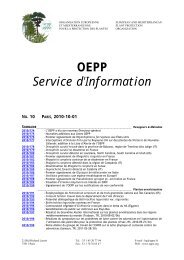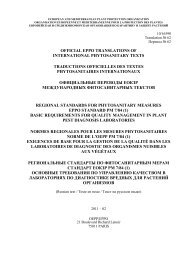EPPO Reporting Service - Lists of EPPO Standards - European and ...
EPPO Reporting Service - Lists of EPPO Standards - European and ...
EPPO Reporting Service - Lists of EPPO Standards - European and ...
Create successful ePaper yourself
Turn your PDF publications into a flip-book with our unique Google optimized e-Paper software.
<strong>EPPO</strong> <strong>Reporting</strong> <strong>Service</strong> – Invasive Plants<br />
Source: Delivering Alien Invasive Species Inventories for Europe<br />
http://www.europe-aliens.org/speciesSearch.do<br />
Kikodze D, Memiadze N, Kharazishvili D, Manvelidze Z, Mueller-Schaerer H (2010)<br />
The alien flora <strong>of</strong> Georgia. 36 pp.<br />
Additional key words: invasive alien plants, new records Computer codes: ACRNE, AILAL, AJASE, AKEBI, AMBEL,<br />
AMHFR, CLZBU, CRSCR, CVCCA, CYPES, ELDCA, ELDDE, ERIBO,<br />
HELTU, HYDRA, MISSI, OPUHU, OPUPH, OXAPC, PASDI, PLEDI,<br />
PLEHU, POLCU, POLPF, PRJFR, RHUJV, ROBPS, SOOCA, SPVJA,<br />
VIXRO, GE<br />
2010/022 Hygrophila polysperma in the <strong>EPPO</strong> region: addition to the <strong>EPPO</strong> Alert<br />
List<br />
Hygrophila polysperma (Acanthaceae, common name: Indian swamp weed) is an aquatic<br />
perennial plant native to Asia. The species is traded as an aquarium plant. Within the <strong>EPPO</strong><br />
region, it is not recorded as naturalized. Because this plant has shown invasive behaviour<br />
where it has been introduced elsewhere in the world, it can be considered a potential<br />
future invader in the <strong>EPPO</strong> region.<br />
Geographical distribution<br />
Asia (native): Bangladesh, Bhutan, Cambodia, China (Guangdong, Guangxi, Yunnan), India,<br />
Lao, Myanmar, Nepal, Pakistan (Sindh), Thail<strong>and</strong>, Vietnam.<br />
North America: USA (Florida, Texas, Virginia), Mexico (Tamaulipas).<br />
Morphology<br />
H. polysperma is a hairy perennial plant with both aquatic <strong>and</strong> emergent stems, which is<br />
rooted in the soil. The aquatic form has opposite, elliptic to oblong leaves <strong>of</strong> 8 cm long <strong>and</strong><br />
2 cm wide. The emergent form differs in having smaller, narrower <strong>and</strong> darker leaves.<br />
Flowers are small, solitary, nearly hidden by leaves, with a bluish-white corolla measuring<br />
8 mm. The fruit is a capsule <strong>of</strong> 7-9 mm long covered with hairs, especially near the top,<br />
splitting length-wise to release 20 to 30 tiny round seeds.<br />
Biology <strong>and</strong> ecology<br />
H. polysperma is reported as a fast-growing <strong>and</strong> fast-spreading invasive plant. Submerged<br />
plants may occupy the entire water column while emergent plants grow in shallow water<br />
areas <strong>and</strong> in saturated sediments along the shoreline. H. polysperma forms monocultures<br />
with emersed stems rooted at 3 m or more below the water surface. In North America,<br />
growth <strong>of</strong> shoots begins with the increase <strong>of</strong> water temperature in March. Shoots reach the<br />
surface in late spring. During summer, fragments with numerous adventitious roots break<br />
away <strong>and</strong> readily root upon contact with soil. These shoots form large <strong>and</strong> heavy floating<br />
mats which can have detrimental impacts. The mat or individuals can sink <strong>and</strong> produce a<br />
new colony. The old root crowns produce new shoots, which grow slowly during the winter.<br />
The importance <strong>of</strong> seeds in plant reproduction is not certain.<br />
The invasive behaviour <strong>of</strong> this plant is considered to be due to its multiple growth forms,<br />
<strong>and</strong> its ability to produce a high biomass <strong>and</strong> to form a dense canopy at the water-air<br />
surface. The species is also considered to be capable <strong>of</strong> positive net photosynthesis at low<br />
light levels. It can subsist within a temperature range <strong>of</strong> 18 to 30°C, <strong>and</strong> a pH range <strong>of</strong> 6.5<br />
to 7.8 (other publications mention a pH range <strong>of</strong> 5-7). The species tends to grow more<br />
23


